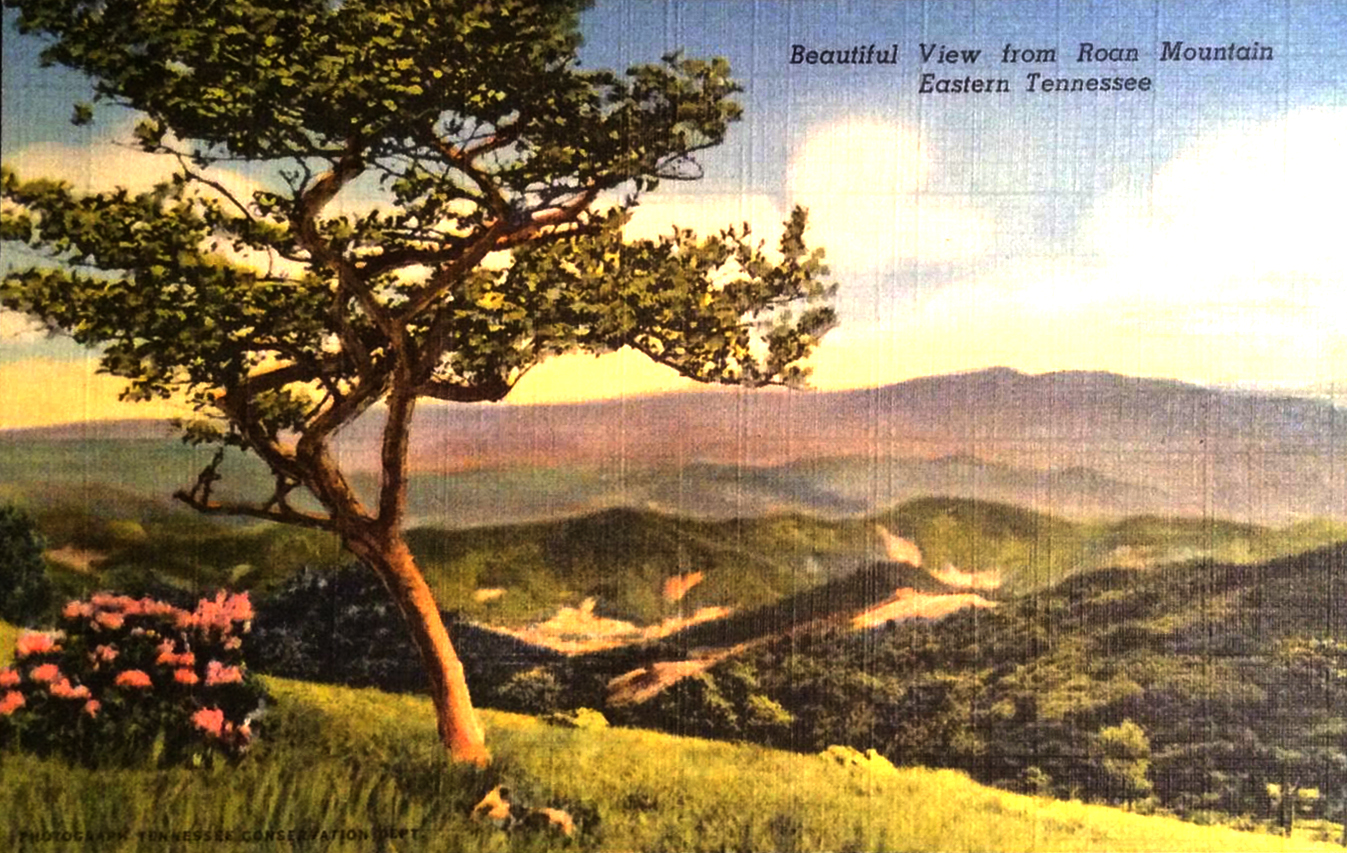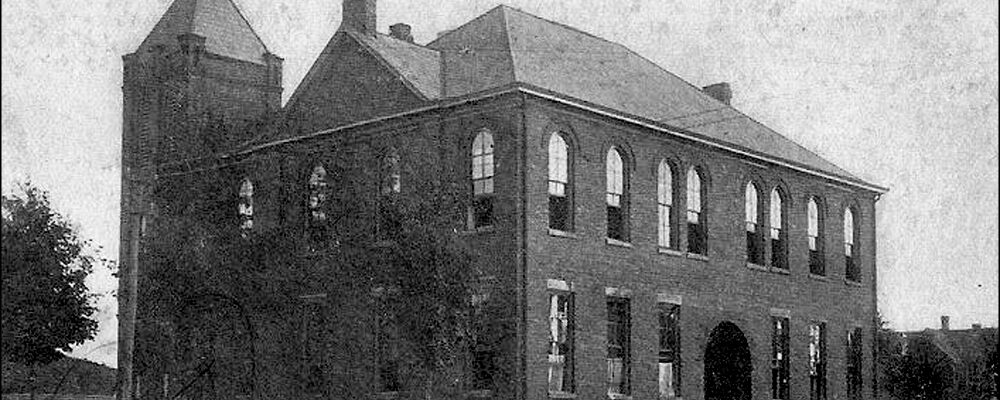In 1953, Mrs. Nannie Snyder Murrell, 82, and her husband, N.L. Murrell, who managed the Cloudland Hotel atop Roan Mountain between 1896 and 1906, arrived in Elizabethton for a visit.
While there, the couple made a special trip to attend the sixth annual Rhododendron Festival and once again revel in the beauty of the rhododendron blossoms. Sadly, the hotel that she had loved so dearly was missing from its once prominent place on the hillside and was but a warmhearted memory.
Mrs. Murrell fondly recalled her days at the Cloudland Hotel, sharing many interesting facts about the resort with which she was so intimately connected for a decade.

A Beautiful Scenic View from Roan Mountain Is Shown On An Old Postcard
In the days she and her husband worked at Cloudland, hotel rooms rented for $2.50 per day, the cost of a medium sized steak in 1953. The charge included a nice room at the nearly inaccessible but highly popular hotel, three tasty meals a day and a relaxing atmosphere to enjoy throughout the long summer days.
Nannie recited, without hesitation, the menu items that were offered by the hotel. Breakfast included bacon, liver, steak, fried apples, fried potatoes, flannel cakes, biscuits, coffee and, of course, eggs. Grits were not on the bill of fare.
The big meal, which was served in the middle of the day, commenced with a choice of two soups, two meat entrees, six vegetables and a selection of four desserts.
Supper, a somewhat lighter fare, consisted of cereal, meats, eggs and funnel cakes, in addition to leftover portions of the luncheon menu.
The fortunate visitor at day's end had the option of reclining on one of the wide porches that ran the length of the south and east sides of the hotel or watching a magnificent sunset majestically bathe the mountaintop in a diffused golden reddish glow. It was serenity at its finest.
Large quantities of flour, sugar and other staple groceries were hauled up the mountain in wagons. Vegetables, eggs and fresh fruits were brought more often to the hotel on horseback. According to Mrs. Murrell, a Mr. Gouge and a Mr. Burleson scoured the countryside around Roan Mountain for fresh meat: beef cattle, hogs and sheep. These were prepared on the mountaintop and safely stored in a house over the ice-cold spring.

Rhododendron Gardens and the Parking Lot Near the Former Cloudland Hotel Location
After all those years, the former worker could vividly remember some of the names of persons who vacationed there. Among the distinguished guests who frequented the hotel was the late Grafton Greene, who later served as Chief Justice of the Supreme Court of Tennessee. He became a celebrated national figure when he wrote the Court's opinion for the famous Scopes Trial held at Dayton, Tennessee in which Clarence Darrow and William Jennings Bryan were opposing attorneys.
Mrs. Murrell further remembered that Louisiana Governor Nichols and his family were guests of the hotel. Dr. Floyd McRae from Atlanta, Georgia came to Cloudland and inspected the hotel before allowing his family to vacation there. He found the place to his liking and visited it on numerous occasions. She also recalled that two of his sons once stayed on Roan Mountain.
The former resident provided a graphic description of the hotel rooms, which she said contained comfortable beds, strips of carpet on the floors, a washstand with a china pitcher and bowl, a dresser and chairs in each room. “We had plenty of cover and used it, too,” she said. “In all my 10 years up there, the temperature was never above 75 degrees and seldom ever dropped below 44 degrees at night.”
On unusually cold evenings, steam heat was turned on. The boiler was fired with wood that had been brought up 3,000 feet from the valley below by means of a cable car. Fireplaces in the main rooms were usually lighted on cool evenings.
The 50-foot great room had the most beautiful solid maple floor imaginable, which glistened when waxed to a high polish. There the hotel guests danced in the evening to the music of a piano, cornet and violin. The musicians, residents of Bristol, were Miss Lucy Kirby, Clyde DeVault and a Mr. Stull. The music was mainly focused on waltzes, square and ballroom dancing.

Rhododendrons Bloom on Top of Roan Mountain In Another Photo from a Postcard
Mrs. Murrell described nearby Profile Rock, which many folks believed bore a striking resemblance to President William McKinley. This site could be reached from Lyons Bluff by crawling between two rocks and traversing along a narrow ledge. Nannie, an avid outdoors person, escorted many guests there over time. Visitors were also accompanied to numerous scenic attractions in the area.
The visitor was especially impressed with the Rhododendron Gardens. She declared, “You have missed a never-to-be-forgotten sight if you have never been there.” She spoke of the 300-foot grassy slope on which the hotel was situated as “the most gorgeous place on earth.” When the wind blew, as it did most of the time, the soft thick carpet of grass resembled a wheat field majestically rippling in the breeze. One half-dozen rhododendron blossoms was enough to satisfy most anyone, but imagine 600 acres in full bloom at one time – that was almost too much magnificence for the body and soul to absorb.
On the north side of the hotel on a little rise, a platform provided a splendid view of the entire area. From this vantage point, the lights of Greeneville, Tennessee were clearly visible and one could even get a view of Cumberland Gap in Kentucky. Many mountains 5,000 feet high and more could also be seen. Mrs. Murrell grudgingly admitted that Mount Mitchell was higher than Roan Mountain but in a spirited manner because Mitchell was uninhabited.
Roan Mountain Hotel and Restaurant as It Appeared in the 1960s
The former employee and guest of honor adequately described an orchid-like flower which she saw in bloom only once on the mountaintop. The blossoms came out around the stem like a double hyacinth, but the fragrance was akin to that of the carnation family. She remembered Gray's lily, a lovely flower resembling the snapdragon called “Painted Lady” and a plant known as “Indian Pipe,” belonging to the mushroom family with a perfect pipe hanging from its stem.
A Mr. Young, who was past 80, had journeyed from Greenwood, Mississippi for relief from asthma and who, upon reaching the mountaintop, was able to breathe freely and enjoy the season there.
Mrs. Mupcrell, daughter of the Snyder family who ran the old Snyder House on North Street, a favorite hotel of that era, knew General Wilder from whom they leased the hotel in their first years on the mountain. She first visited the mountaintop with a party while lumber was being sawed for the large hotel. She recalled they walked from Carver's Gap to the summit.
During the 1953 visit, Mrs. Murrell was looking forward to the day when another hotel might be built on Roan Mountain to ensure that more people would become acquainted with and love the natural beauty which abounded on its majestic peak. She recalled that, for days at a time, low hanging clouds would envelope the hotel in a ghostly white mist, wholly obstructing the view. But as the fog lifted and the sun made its welcome approach, the lodge again became an absolute paradise.
Mrs. Murrell's adoration of the Cloudland Hotel and Roan Mountain allowed her to leave many footprints on her favorite mountain, which she said still remain there in spirit.








